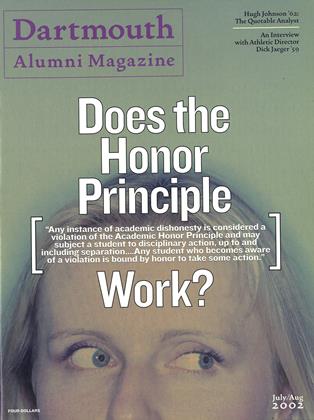QUOTE/UNQUOTE "It was a really nice-feeling earthquake. It just makes you fee! attuned to nature when you get to experience something like that." EARTH SCIENCES PROFESSOR JIM ARONSON ON THE 5.1-MAGNITUDE EARTHQUAKE THAT SHOOK THE HANOVER AREA APRIL 20
MORE THAN A CENTURY AFTER IT first opened, the new and improved Hanover Country Club (HCC) reopens July 1. A two-year, $3-million renovation has transformed the lackluster par 69 into a classic par 71, with 18 new greens and four new sets of tees for each hole. The biggest change is in the form of four entirely new holes (gone forever are the old Nos. 7, 12, 16 and 17). Some 50 donors, primarily alumni, donated to the project, led by a major gift of $1 million from Margaret and Robert Keler '36.
"The renovation will provide golfers throughout the Upper Valley with a course more suited to all levels of play," says Roger Demment, associate director of athletics. "At the same time it will present the most accomplished players, local and collegiate, with a true test of golf. The Hanover Country Club will now compare favorably with the best courses in northern New England."
For those of you fond of using the course for activities other than golf, fear not. Demment insists the "character of the surrounding area" has been maintained. That means it can continue to serve as a haven for sledders and skiers in the winter and a welcome entrance to Pine Park for walkers and runners. "It is a win-win situation for all," says Demment.
The HCC renovation was executed by noted golf course architect Ron Prichard, recognized for his traditional approach to upgrading classic courses. He also recently designed the Tourna- ment Players Club in Tennessee, a PGA tour stop .DAM asked Prichard about his latest creation:
Enlarging the course from 5,800 yards to 6,500 is a 12 percent increase. Will the course be 12 percent harder? "Yes, maybe 15 or 20 percent."
You've carved four completely new holes out of the woods. What else? "We increased the size and contours of the greens, doubled the number of bunkers and redesigned the old ones to modern standards. There are more, and larger, teeing areas. I think of a golf course as being 18 different sculptures."
Is there a Ron Prichard philosophy? "Golf is a game of angles. The degree of difficulty of a hole is a combination of length and risk. Since 1945 difficulty off the tee has been a principal design factor, but I believe par is defended at the green."
How does HCC fit in with other older courses you've rehabilitated ? "This course has an old charm. It fulfills certain expectations you have of a 100year-old course. It's an appreciation of early American golf. It fits the area." How so?
"The course has quirky charms you won't find on most modern courses, such as consecutive par fives as the two closing holes and the criss-crossing [tee areas] of 6 and 18."
Did you have to make any major adjustments after work began? "No, but you have to be on site. You can't do it in your office. There were, and are, extreme variations in the topography at the Hanover course. The new course is going to be a good, solid, honest test. Working on this course has been one of my best experiences."
Tee Time Hanover Country Clubhead pro Jason Calhoun lets it flyat the new 16th hole.
 View Full Issue
View Full Issue
More From This Issue
-
 Cover Story
Cover StoryA Matter of Principle
July | August 2002 By Rick Green -
 Feature
FeatureThe Quotable Analyst
July | August 2002 By Bryant Urstadt ’91 -
 Feature
FeatureFENG SHUI COMES TO DARTMOUTH
July | August 2002 By ROBERT NUTT '49 -
 Outside
OutsideRunning With Wild Abandon
July | August 2002 By Jay Heinrichs -
 Interview
Interview“We’ve Got To Go For It”
July | August 2002 By Brad Parks ’96 -
 CLASSROOM
CLASSROOMHeaven and Hell in the Middle East
July | August 2002 By Alex Hanson
Article
-
 Article
ArticleLate Sports Results
January 1939 -
 Article
ArticleHopkins House
MAY 1970 -
 Article
ArticleOther Sports
June 1955 By Cliff Jordan '45 -
 Article
ArticleDR. WHEELOCK'S ALMANACK
March 1934 By David McClure & Elijah Parish -
 Article
ArticleZombie of the 1902 Room
October 1979 By MICHAEL COLACCHIO '80 -
 Article
ArticleDartmouth's Intellectual Life
APRIL 1929 By Professor A. J. Scarlett

